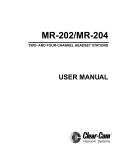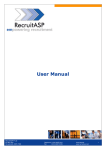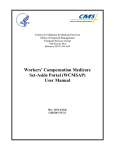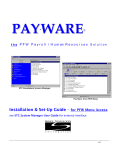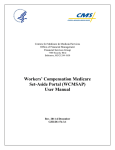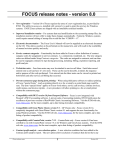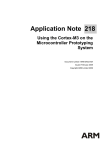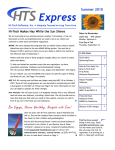Download March 2010 - AACIWeb.com Healthcare Consulting | Abbey
Transcript
Abbey & Abbey, Consultants, Inc. Medical Reimbursement Newsletter A Newsletter for Physicians, Hospital Outpatient & Their Support Staff Addressing Medical Reimbursement Issues March 2010– Volume 22 Number 3 ISSN: 1061-0936 judgment, award, or other payment to satisfy an alleged claim (including any deductible or copay on a liability insurance, no-fault insurance, or workers’ compensation law or plan) for a business, trade or profession. See also 42 C.F.R. 411.50. APC/APG Update st Watch for any new guidance on APCs for the April 1 quarterly update. Be certain to review both the APC transmittal and the I/OCE transmittal. There have been no indications of significant changes. Be certain to review any changes or additions to the HCPCS coding system as well. Also, now is the time to start watching for the MS-DRG proposed update for FY2011. MSP Mandatory Reporting - Update The reporting date for NGHPs (Non-Group Health Plans) has been moved out to January 1, 2011. Apparently, CMS has recognized that there are many unanswered questions, and more guidance is needed. Also, Version 3.0 of the NGHP User’s Manual was issued on February 25, 2010. There are many changes and additions. The main question for hospitals and other healthcare providers is whether or not the mandatory reporting does or could apply to them. In other words, is your hospital an RRE, Responsible Reporting Entity, under the MSP mandatory reporting? Note: If this reporting issue were simply a routine process, then hospitals and healthcare providers would not worry unduly about the subtle issues that we are discussing. However, the penalties and fines in this area are horrendous and amount to $1,000.00 per day per case. Any kind of a misstep could result in huge fines. The phrase deemed self-insurance is of importance. Whenever words like deemed or imputed are used, then situations that do not obviously apply suddenly come under scrutiny. Now your hospital or clinic may overtly retain some liability relative to possible liability claims. This may even be in the form of a retained deductible that you pay in connection with other liability payments. Note: From the perspective of the mandatory reporting for MSP, it would be better if the healthcare provider paid the deductible to the insurance company and then had the insurance company make any payments to patients as claimants. This way the insurance company bears the burden of being the RRE. Now overt self-insurance and/or retention of some liability is easily recognizable, and you can make decisions about being an RRE as appropriate. However, what about the subtle situations in which you may be addressing patient dissatisfaction? Let us join the Apex Medical Center for two situations that are creating concern about whether Apex is an RRE or not. Case Study 1 – The Apex Medical Center has a policy that if a patient, including Medicare beneficiaries, has a minor complaint (slow service, parking lot full, rude employee, etc.) that does not directly involve medical issues, that gift certificates of either $25.00 or $50.00 can be provided. Here is the key definition from the User’s Manual. 42 U.S.C. 1395y(b)(2)(A) provides that an entity that engages in a business, trade or profession shall be deemed to have a self-insured plan if it carries its own risk (whether by a failure to obtain insurance, or otherwise) in whole or in part. Self-insurance or deemed self-insurance can be demonstrated by a settlement, While a formal legal opinion would be necessary, this type of customer service arrangement would not appear to cause Apex to be an RRE and go through the process Page - 13 - Step 4 – RRE Account Setup on the COBSW – Account Manager Step 5 – Return Signed RRE Profile Report – Authorized Representative of setting up reporting to the COB (Coordinator of 1 Benefits) through the COBWS (COB Website). Case Study 2 - The Apex Medical Center has worked extensively on policies of writing-off deductibles and co-payment based upon financial need. This policy is for all patients, including Medicare beneficiaries. Many, if not most, hospitals and other healthcare providers have provisions for writing-off deductibles and co-payments under specific financial circumstances. While this type of process would not appear to fall under 2 any sort of liability payment, be certain to watch for further guidance. Under the assumption that you have analyzed the possibility of being an RRE, what if you conclude that you are not an RRE and that you would not have anything to report? Here is the comment from the User’s Guide. NGHP RREs that expect to have nothing to report are not required to register until such time as the RRE determines published CMS guidance establishes that the RRE will have claims to report. However, when they do have a reasonable expectation of having claims to report they must then register in enough time to allow a full calendar quarter for data transmission testing prior to sending production files. Note that the process of registering and then testing the ability to transmit and receive the various files takes a significant amount of time. Because you never quite know what kinds of situations might arise in the future, you may want to register as a contingency, just in case something happens that you didn’t anticipate. As you can probably tell, even from this simple listing, a significant bureaucracy has been developed to address this whole reporting process. Be certain to carefully read the User’s Guide that has now become several hundred pages long. Editor’s Note: See a related article in the February issue of this Newsletter. Also, see the Questions from Our Readers section concerning situations in which the hospital forgives payment in certain cases that possibly might be construed to require reporting. Supplies & Devices – Another Continuing Saga Issues surrounding supplies, biologicals, implants, and devices never seem completely clear. CMS continues to provide guidance that is often puzzling, at least at face value. One of the more recent sources of information has been the transmittals that update and clarify the APC payment system and the associated Integrated Outpatient Code Editor (I/OCE). Note: As we discuss some recent guidance from CMS, keep in mind that packaging is a payment issue. Hospitals are typically concerned about charging issues. In theory, these two concepts are separate, but CMS tends to merge them in their discussions. From Transmittal 1803, August 28, 2009 there are two paragraphs providing additional guidance concerning drugs, biologicals, and radiopharmaceuticals. While the topic appears limited, the language seems quite broad. “When billing for biologicals where the HCPCS code describes a product that is solely surgically implanted or inserted, whether the HCPCS code is identified as having pass-through status or not, hospitals are to report the appropriate HCPCS code for the product. In circumstances where the implanted biological has passthrough status, a separate payment for the biological is made. In circumstances where the implanted biological does not have passthrough status, the OPPS payment for the biological is packaged into the payment for the associated procedure.” If you decide to take a minimalist approach, then you may want to register and then use an agent to handle the entire computer related communications, testing, etc. While there is some cost, this may simplify the process. See the User’s Manual for more information on registering. Here are the basic steps for registering. Step 1 – Identify an Authorized Representative, Account Manager and Other COBSW Users Step 2 – Determine Reporting Structure Step 3 – RRE Registration on the COBSW – New Registration 1 This statement appears logically consistent. Unless the implanted or inserted biological has pass-through status, payment for the item is packaged. Now CMS is quite clear on the charging and billing side in that hospitals are to report the appropriate HCPCS code for the product. See OIG Advisory Opinion 08-07, June 27, 2008. In this case the word payment is referring to not collecting from the patient, which has the effect of paying the patient by not collecting. Page - 14 2 Presumably, this would include a charge based on costs using typical markup formulas. Note that the instruction to report the HCPCS or CPT code means that the hospital is instructed to separately report or, equivalently, separately bill for the item. While there is mixed language relative to payment and then also to charging/billing, everything appears logically consistent. Now to the second paragraph. “When billing for biologicals where the HCPCS code describes a product that may either be surgically implanted or inserted or otherwise applied in the care of a patient, hospitals should not separately report the biological HCPCS code, with the exception of biologicals with passthrough status, when using these items as implantable devices (including as a scaffold or an alternative to human or nonhuman connective tissue or mesh used in a graft) during surgical procedures. Under the OPPS, hospitals are provided a packaged APC payment for surgical procedures that includes the cost of supportive items, including implantable devices without pass-through status. When using biologicals during surgical procedures as implantable devices, hospitals may include the charges for these items in their charge for the procedure, report the charge on an uncoded revenue center line, or report the charge under a device HCPCS code (if one exists) so these costs would appropriately contribute to the future median setting for the associated surgical procedure.” Amazingly, this paragraph consists of three sentences. The first two sentences tell us that implantable biologicals are not reported separately unless they are pass-through items. This means the HCPCS code is not included during the billing process. Obviously, a passthrough item must be reported with an appropriate HCPCS and proper charge because the payment for the item will use the charge times the appropriate cost-tocharge ratio (CCR) as the payment. Now the last sentence appears as more general guidance in which biologicals are a specific instance. In the statement there are three ways to charge that are listed: On the surface, the third way to charge appears to contradict the guidance in the first sentence concerning not reporting (i.e., not coding) the biological. While this statement is certainly open to interpretation, the third alternative appears to apply to those situations in which the HCPCS must be reported to gain proper payment (i.e., Status Indicator “G”, “H” or “K”). Of course this general guidance does not apply to the various supply and implantable items that have C-codes such as stents, pacemakers and the like. These items must be reported with C-codes and, hopefully, with meaningful charges (i.e., charge appropriately based on costs). These are all Status Indicator “N” so that payment is packaged. Editor’s Note: Abbey & Abbey, Consultants, Inc. has developed an ever lengthening position paper on supply categorization. This paper is currently being updated to Version 13.0. If you would like a copy of the updated paper, please contact [email protected]. Questions from Our Readers Question: On Monday a Medicare patient presents to the ED after an automobile accident. The ED services amount to $5,000.00. The automobile insurance is billed and eventually pays $3,000.00. In the meantime on Wednesday the same patient presents to the ED with an exacerbation of a chronic condition that is totally unrelated to the automobile accident. The patient is admitted to the hospital using diagnosis codes that are different from the diagnosis codes relative to the accident. Medicare pays for the inpatient admission. However, when submitting the Medicare secondary claim for the remaining $2,000.00 charges from the accident case, the claim is being returned indicating that there is a violation of the DRG Pre-Admission window. What should we do? The most immediate answer to this situation is to contact your FI or Part A MAC. You will need to ask them to manually review the two claims. Additionally, you should be prepared to support your situation that the secondary claim is appropriate and not a part of the inpatient stay two days later. This question really illustrates a major issue with filing a primary claim to one payer and then a secondary to Medicare. Because the Medicare program has special claim filing requirements that the primary payer does not have, a disconnect can rapidly arise. As we go through an analysis of this particular case, look for places where there may be ambiguity in proper claims filing. i. Include charges for the item in the charges for procedure (i.e., bundle the charges into the procedure), ii. Report the charge on an uncoded revenue center line (i.e., separately charge without HCPCS), iii. Report the charge under a device HCPCS code if one exists (i.e., separately report or bill). Page - 15 - At issue in this question is the proper interpretation and application of the DRG Pre-Admission Window. This is sometimes called the ’72-hour rule’, but this is really a misnomer. The window is three dates-of-service before the patient’s admission. If the patient is admitted late in the day the number of hours could approach 96 hours. definitive diagnosis of pneumonia is developed. Most likely, the principal diagnosis and primary diagnosis will be different. Notes: 1. The interpretation of the primary diagnosis is not as precise on the outpatient side as it is on the inpatient side. The primary diagnosis on the 1500 claim form is the first diagnosis for an individual line-item on the claim. For hospital outpatient claims the principal diagnosis is the first diagnosis and goes into the ‘principal diagnosis’ location on the UB-04. 2. From time to time you should anticipate adjudication issues or even issues raised from your QIO. Be prepared to fully analyze and justify your coding. For example, the DRG assignment can be affected by pre-admission services and associated diagnosis coding through inclusion or exclusion. 3. Whether the RACs (Recovery Audit Contractors) will address this pre-admission window is yet to be answered. Basically, the guidance surrounding this window is that certain outpatient services provided during the window are to be included in the inpatient billing. Alright, so exactly which services must be included? First of all, the Medicare rules indicate that all diagnostic services, related or not, must be put on the inpatient claim. During the first encounter in the ED there probably were some diagnostic tests performed. Most likely these tests include laboratory and radiology services. This means that for Medicare, the laboratory and radiology from the first encounter should go onto the inpatient claim for the second encounter. But now, what about the primary payer for the ED services? Should they not be billed for these diagnostic services? Or perhaps we should simply remove the laboratory and radiology services when we file the secondary claim to Medicare for the first encounter? Second, the window requires that any related services (i.e., related to the inpatient admission) provided in the window be included on the inpatient claim. The key word is ‘related’. Just what does this mean? Bottom-Line: Anticipate that you will need to address DRG Pre-Admission Window concerns. Be fully prepared to explain your position, coding processes and the proper application of the CMS guidance in this area. Here are the main citations. 1. February 11, 1998 Federal Register, 2. Program Memorandum A-03-013, February 14, 2003, 3. Transmittal 1429, February 1, 2008, 4. 42 CFR §412.2, 5. Medicare Intermediary Manual, §3610.3. From the February 11, 1998 Federal Register, page 6866: “We [CMS] note that we have defined services as being related to the admission only when there is an exact match between the ICD–9–CM diagnosis code assigned for both the preadmission services and the inpatient stay.” (63 FR 6866) This means that for therapeutic services to meet the ‘relatedness’ criterion, there must be an exact match between the principal diagnosis for the inpatient claim and the primary diagnosis for the outpatient services. While such a match can occur, the specificity of the principal diagnosis for the inpatient admission will tend to be greater than for the outpatient services. For example, a patient may present to a family practice 3 provider-based clinic with cough, congestion and fever. While the patient is treated, two or three days later the patient may be admitted to the hospital, and then a 3 Question: If a patient is admitted as an inpatient and is discharged the next day before Utilization Review can check the case and it is determined after the fact that the case should have been an observation case, what billing can we make? Obviously, we did not have the opportunity to use Condition Code 44. Can we bill this as a noncovered service? There is not a great deal of guidance for this particular situation. One document that does mention this situation is from AdminaStar Federal, Inc. In two-page document entailed ‘Hospital Guidelines for Outpatient Observation Services’ issued in December, 2002, we have: Note that the trigger for applying the DRG Pre-Admission Window is ‘owned or operated’ by the hospital. While provider-based clinics fall under this trigger, your hospital may also have freestanding clinics that are owned or operated. Page - 16 - “If a hospital determines, after the patient’s discharge, that an inpatient admission was not medically necessary, the inpatient admission should be billed provider liable (aka “no-pay bill”).” Also, Part B inpatient services, that is, ancillary services, can be billed. These, generally, are relatively minimal. See CMS Publication 102, Medicare Benefit Policy Manual, Chapter 6, §10. Basically, there is very little that a hospital can do in situations of this type other than absorb the costs. Question: When a ‘never event’ occurs, the Medicare program does not pay for the services, and, basically, the hospital takes financial responsibility for the services. Does this kind of situation fall under the MSP mandatory reporting requirements? The hospital is taking responsibility that may even involve an ongoing liability. In some cases, there will be a liability settlement. In other cases, there could simply be a loss in payment. There is no simple answer to this question given the current status of the mandatory reporting under MSP. Given the convoluted interpretations and logic trains of thought that are involved with current Medicare laws, rules and regulations, this kind of concern is justified to some degree. This same logic can be applied to conditions that are not present on admission and develop during a hospital inpatient stay. For these POA situations, the MS-DRGs will reduce the payment by not considering those conditions that were not present on admission. Thus, the hospital, in some sense, assumes financial liability for the services. Because the hospital has assumed primary liability for these situations, does that mean that Medicare is secondary? While the issues of ‘never events’ and not present on admission would not appear related to the mandatory reporting for MSP, you should watch carefully for developments and future guidance. Note: As an exercise consider the logic used in this question and apply the same thought pattern to the preceding question. That is, take the fact that there was an inpatient stay for which the hospital takes responsibility due to not correctly classifying the stay. Does taking this financial responsibility then mean anything to the hospital assuming liability for ongoing services relative to the conditions requiring the hospital stay? Once again the application of this type of logic appears well outside any reasonable norm. However, given all of the fraud, abuse and recoupment efforts that are underway, hospitals and other healthcare providers must consider even remote possibilities. Current Workshop Offerings Editor’s Note: The following lists a sampling of our publicly available workshops. A link for a complete listing can be found at: www.aaciweb.com/JantoDecember2010EdCal.htm On-site, teleconferences and Webinars are being scheduled for 2010. Contact Chris Smith at 515-2326420 or e-mail at [email protected] for information. A variety of Webinars and Teleconferences are being sponsored by different organizations. Georgia Hospital Association, Ohio Hospital Association, Florida Hospital Association, Instruct-Online, Texas Hospital Association, and the Eli Research Group are all sponsoring various sessions. Please visit our main website listed above for the calendar of presentations for CY2010. The Georgia Hospital Association is sponsoring a series of Webinars. Presentations are planned for all of CY2010. For more information, contact Carol Hughes, Director of Distance Learning at (770) 249-4541 or [email protected]. The webinar scheduled for April th 20 “Physician Supervision for Provider-Based Clinics” that will run from 9:30 a.m. to 11:00 a.m. EST. Dr. Abbey’s eighth book, “Compliance for Coding Billing & Reimbursement: a Systematic Approach to Developing a Comprehensive Program” is now nd available. This is the 2 Edition published by CRC Press. ISBN=978156327681. There is a 20% discount for clients of AACI. See [email protected] for information. Also, Dr. Abbey’s ninth book, “The Chargemaster Coordinator’s Handbook” available from HCPro. His tenth book, “Introduction to Healthcare Payment Systems” is available from Taylor & Francis. Contact Chris Smith concerning Dr. Abbey’s books: • Emergency Department Coding and Billing: A Guide to Reimbursement and Compliance • Non-Physician Providers: Guide to Coding, Billing, and Reimbursement • ChargeMaster: Review Strategies for Improved Billing and Reimbursement, and • Ambulatory Patient Group Operations Manual • Outpatient Services: Designing, Organizing & Managing Outpatient Resources • Introduction to Payment Systems is available from Francis & Taylor. A 20% discount is available from HCPro for clients of Abbey & Abbey, Consultants. E-Mail us at [email protected]. Abbey & Abbey, Consultants, Inc., Web Page Is at: http://www.aaciweb.com http://www.APCNow.com http://www.HIPAAMaster.com Page - 17 - Abbey & Abbey, Consultants, Inc. Administrative Services Division P.O. Box 2330 Ames, IA 50010-2330 EDITORIAL STAFF INSIDE THIS ISSUE APC/APG Update MSP Mandatory Reporting - Update2 More on Supplies and Devices Questions from our Readers Duane C. Abbey, Ph.D., CFP - Managing Editor Mary Abbey, M.S., MPNLP - Managing Editor FOR UPCOMING ISSUES Penny Reed, RHIA, ARM, MBA - Contributing Editor Linda Jackson, LPN, CPC, CCS - Contributing Editor Contact Chris Smith for subscription information at 515232-6420. Medicare Secondary Payer – Part 3 More on RAC Audits and Issues Chargemaster Pricing Issues More on Coding, Billing Compliance More on Payment System Interfaces 2010 Abbey & Abbey, Consultants, Inc. Abbey & Abbey, Consultants, Inc., publishes this newsletter twelve times per year. Electronic subscription is available at no cost. Subscription inquiries should be sent to Abbey & Abbey, Consultants, Inc., Administrative Services, P.O. Box 2330, Ames, IA 50010-2330. The sources for information for this Newsletter are considered to be reliable. Abbey & Abbey, Consultants, Inc., assumes no legal responsibility for the use or misuse of the information contained in this Newsletter. CPT® Codes 2010-2009 by American Medical Association. ****** ACTIVITIES & EVENTS ****** Schedule your Compliance Review for you hospital and associated medical staff now. A proactive stance can assist hospitals and physicians with both compliance and revenue enhancement. These reviews also assist in preparing for the RACs. Worried about the RAC Audits? Schedule a special audit study to assist your hospital in preparing for RAC audits. Please contact Chris Smith or Mary J. Wall at Abbey & Abbey, Consultants, Inc., for further information. Call 515-232-6420 or 515-292-8650. E-Mail: [email protected] Need an Outpatient Coding and Billing review? Charge Master Review? Concerned about maintaining coding billing and reimbursement compliance? Contact Mary Wall or Chris Smith at 515-232-6420 or 515-292-8650 for more information and scheduling. E-Mail: [email protected]. Page - 18 -






